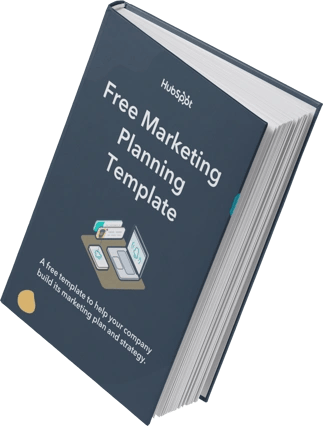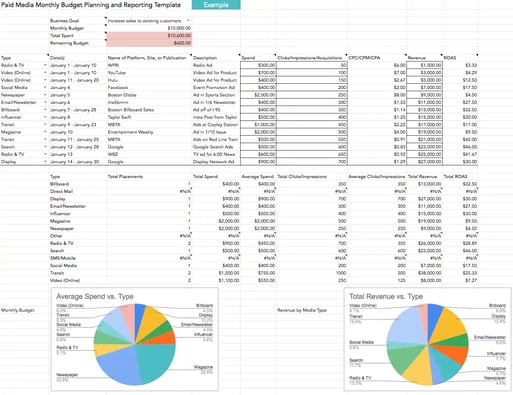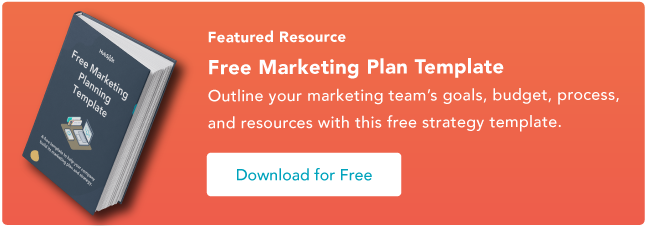[ad_1]
Would it be correct to assume a major part of your marketing strategy today is digital? Probably.
Consumers and businesses alike are almost always online and on the go – and you want to be able to reach them and observe their behavior where they spend their time.
But when you’re growing a business, this ever-changing digital landscape can quickly become an overwhelming one. With a number of other responsibilities and tasks that you need to do, how can you also efficiently create, fine-tune, and maintain an agile digital marketing strategy?
We’ve put together this guide about marketing strategies to help you improve your digital presence and grow better.
What is a marketing strategy?
A marketing strategy is a plan for reaching a specific marketing-related goal (or goals) in a focused and achievable way. It takes into consideration what your business is currently doing well and what you’re missing in regards to the objective you set, then developing tactics to help you meet your goal.
If you‘re a small business and you’re unsure how to jumpstart your strategy, this digital marketing strategy template will help you get there. It includes actionable tips and templates to set you up for success.
Now back to this — are you confused about the difference between a marketing strategy and marketing tactics? We cover that below.
Strategy vs. Tactic
The difference between a strategy and a tactic lies in their scope, level of detail, and time frame. A strategy is a high-level plan that guides your direction and long-term goals and how you plan on accomplishing them. Tactics, however, are specific actions and methods used to implement your strategy and achieve short-term objectives.
Characteristics of a Strategy
Marketing or not, there are three parts of any strategy:
- A diagnosis of your challenge
- A guiding policy for dealing with the challenge
- A set of targeted actions that are necessary to accomplish the policy
Depending on the scale of your business, your marketing strategy may include several moving parts, each with different goals. With that said, working on your strategy can become daunting at times.
So, if you’re ever feeling overwhelmed about your marketing strategy, refer to these three steps to keep you focused on achieving your objectives.
Characteristics of a Tactic
While strategies provide a framework for your overall vision, tactics determine the specific steps taken to execute that vision.
A good tactic should:
- Be specific, actionable, and measurable
- Align with the overall strategy
- Have a relatively short time frame
Depending on your marketing strategy, your tactics may include email marketing campaigns, publishing a blog, or organizing an event.
Now, let’s look at digital marketing strategy.
What is digital marketing strategy?
A digital marketing strategy is a plan for using online channels to establish an internet presence and achieve specific marketing objectives. These channels can include organic search, social media, paid ads, and other web-based mediums such as your website. Ultimately, the goal is to boost your business’s visibility and attract new customers.
A strong digital marketing strategy helps your business achieve specific digital goals through carefully selected mediums. Similar to marketing strategies versus marketing tactics, “digital marketing strategy” and “digital marketing campaign” are also often interchanged. So, how do they differ?
We cover that in the following sections.
What is a digital marketing campaign?
Digital marketing campaigns are the building blocks and actions within your digital marketing strategy that move you toward a specific end goal.
For instance, if the overarching goal of your digital marketing strategy is to generate more leads through social media, you might run a digital marketing campaign on Twitter. You may share some of your business’s best-performing gated content on Twitter to generate more leads through the channel.
How to Create a Digital Marketing Strategy
- Build your buyer personas.
- Identify your goals and the digital marketing tools you’ll need.
- Evaluate your existing digital channels and assets.
- Audit and plan your owned media campaigns.
- Audit and plan your earned media campaigns.
- Audit and plan your paid media campaigns.
- Bring your digital marketing campaigns together.
1. Build your buyer personas.
For any marketing strategy – digital or not – you need to know who you’re marketing to. The best digital marketing strategies are built upon detailed buyer personas, and your first step is to create them.
Buyer personas represent your ideal customer(s) and can be created by researching, surveying, and interviewing your business’s target audience.
It’s important to note that this information should be based upon real data whenever possible, as making assumptions about your audience can cause your marketing strategy to move in the wrong direction.
To get a rounded picture of your persona, your research pool should include a mixture of customers, prospects, and people outside your contacts database who align with your target audience.
But what kind of information should you gather for your own buyer persona(s) to inform your digital marketing strategy?
That depends on your business — it‘s likely to vary depending on whether you’re B2B or B2C, or whether you sell a high-cost or low-cost product.
Here are some starting points that you can fine-tune and tailor to your particular business.
Quantitative and Demographic Information
- Location: Use web analytics tools to easily identify what location your website traffic is coming from.
- Age: Depending on your business, this may or may not be relevant information. But if it is, it’s best to gather this data by identifying trends in your existing prospect and contact database.
- Income: It’s best to gather sensitive information like personal income through persona research interviews, as people might be unwilling to share these details via online forms.
- Job Title: This is something you can get a rough idea of from your existing customer base and is most relevant for B2B companies.
Qualitative and Psychographic Information
- Goals: Depending on what challenge your product or service solves, you may already have a good idea of the goals of your buyer persona. Cement your assumptions by speaking to real customers and internal sales and customer service reps.
- Challenges: Speak to customers, sales and customer service reps, and any other customer-facing employees to get an idea of the common challenges your audience members face.
- Hobbies/Interests: Ask customers and those who align with your target audience about their hobbies and interests. If you‘re a fashion brand, for example, it’s helpful to know if large segments of your audience are also interested in fitness and well-being to inform future content and partnerships.
- Priorities: Talk to customers and target audience members to find out what‘s most important to them in relation to your business. For example, if you’re a B2B software company, knowing your audience values customer support over a competitive price point is very valuable information.
By combining all of these details, you’ll be able to create buyer personas that are accurate and highly valuable for your business.
2. Identify your goals and the digital marketing tools you’ll need.
Your marketing goals should always be tied back to the fundamental goals of your business.
For example, if your business‘s goal is to increase online revenue by 20%, your marketing team’s goal might be to generate 50% more leads via the website than the previous year to contribute to that success.
Download the Template
Whatever your overarching digital marketing goal is, you must be able to measure the success of your strategy along the way with the right digital marketing tools.
For instance, the Reporting Dashboard in HubSpot brings all of your marketing and sales data into one place, so you can quickly determine what works and what doesn’t to improve your strategy for the future.
3. Evaluate your existing digital channels and assets.
When reviewing your existing digital marketing channels and assets to determine what to incorporate in your strategy, it’s helpful to first consider the big picture — this will prevent you from feeling overwhelmed or confused.
Gather what you have, and categorize each vehicle or asset in a spreadsheet, so you have a clear picture of your existing owned, earned, and paid media.
Owned, Earned, Paid Media Framework
To do this effectively, use the owned, earned, and paid media framework to categorize the digital “vehicles,” assets, or channels you‘re already using and decide what’s a good fit for your strategy.
Owned Media
This refers to the digital assets your brand or company owns — whether that’s your website, social media profiles, blog content, or imagery. Owned channels are what your business has complete control over.
This can also include some off-site content you own that isn’t hosted on your website (e.g. a blog you publish on Medium).
Earned Media
Earned media refers to the exposure you earn through word-of-mouth marketing. Whether that‘s content you’ve distributed on other websites (e.g. guest posts), PR work you‘ve been doing, or the customer experience you’ve delivered. Earned media is the recognition you receive as a result of these efforts.
You can earn media by getting press mentions and positive reviews as well as by people sharing your content via their networks (e.g. social media channels).
Paid Media
Paid media refers to any vehicle or channel you spend money on to catch the attention of your buyer personas.
This includes things like Google Ads, paid social media posts, native advertising (e.g. sponsored posts on other websites), or any other medium through which you pay in exchange for increased visibility.
Since you have a better grasp of what this framework entails, let’s look at an example.
Owned, Earned, and Paid Media Framework Example
Say you have an owned piece of content on a landing page on your website that’s been created to help you generate leads. You know you want to incorporate different parts of the framework rather than just working with owned, earned, or paid media alone.
To amplify the number of leads the content generates, you make an effort to ensure it’s shareable so your audience can distribute it via their social media profiles. In return, this will increase traffic to your landing page. This is the earned media component.
To support your content’s success, you might post about the content on your Facebook page and pay to have it seen by more people in your target audience.
This is how the three parts of the framework are able to work together — although, it’s not necessary for success. For instance, if your owned and earned media are already both successful, you might not need to invest in paid. So, evaluate the best solution to help you meet your goal, and then incorporate the channels that work best for your business into your digital marketing strategy.
Now you know what’s already being used, you can start to think about what to keep and what to cut.
Keep track of your paid media efforts with this free Paid Media Template.
4. Audit and plan your owned media campaigns.
At the heart of digital marketing is owned media — and it almost always comes in the form of content. That‘s because nearly every message your brand broadcasts can be classified as content, whether it’s an About Us site page, product descriptions, blog posts, ebooks, infographics, podcasts, or social media posts.
Content helps convert your website visitors into leads and customers while improving your brand’s online presence. And when this content is search engine optimized (SEO), it can boost your search and organic traffic.
Whatever your digital marketing strategy goal is, you’ll want to incorporate owned content. To start, decide what content will help you reach your goals.
If your goal is to generate 50% more leads via the website than last year, your About Us page is most likely not going to be included in your strategy, unless that page has somehow been a lead-generation machine in the past.
Here’s a brief process you can follow to work out what owned content you need to meet your digital marketing strategy goals.
Audit your existing content.
Make a list of your existing owned content, and rank each item according to what has previously performed best in relation to your current goals.
For example, if your goal is lead generation, rank your content according to which pieces generated the most leads over the last year (such as a blog post, ebook, or site page).
The idea here is to figure out what‘s currently working, and what’s not so that you can set yourself up for success when planning future content.
Identify gaps in your existing content.
Based on your buyer personas, identify any gaps in the content you have.
For example, if you’re a math tutoring company and know through research that a major challenge for your personas is finding effective ways to study, create some.
By looking at your content audit, you might discover that ebooks hosted on a certain type of landing page convert really well (better than webinars, for example).
In the case of this math tutoring company, you might make the decision to add an ebook about “how to make studying more effective” to your content creation plans.
Create a content creation plan.
Based on your findings and the gaps you‘ve identified, make a content creation plan outlining the content that’s necessary to help you hit your goals.
This should include:
- A title
- Format
- A goal
- Promotional channels
- Why you’re creating the content
- The priority level of the content
This can be a simple spreadsheet, and should also include budget information if you‘re planning to outsource the content creation, or a time estimate if you’re producing it yourself.
5. Audit and plan your earned media campaigns.
Evaluating your previous earned media against your current goals can help you get an idea of where to focus your time. Look at where your traffic and leads are coming from (if that’s your goal) and rank each earned media source from most effective to least effective.
You can obtain this information using tools like the Sources reports in HubSpot’s Traffic Analytics tool.
You may find a particular article you contributed to the industry press drove a lot of qualified traffic to your website, which boosted conversions. Or, you may discover LinkedIn is where you see most people sharing content, which increases traffic.
The idea is to build a picture of what types of earned media will help you reach your goals (and what won‘t) based on historical data. However, if there’s something new you want to experiment with, don‘t rule it out just because it’s never been done before.
6. Audit and plan your paid media campaigns.
This process involves much of the same process: You need to evaluate your existing paid media across each platform (e.g. Google Ads, Facebook, Twitter, etc.) to figure out what’s most likely to help you meet your current goals.
If you‘ve spent a lot of money on Ads and haven’t seen the results you‘d hoped for, maybe it’s time to refine your approach, or scrap it altogether and focus on another platform that seems to be yielding better results.
Use this free guide for more on how to leverage Google Ads for your digital marketing strategy.
By the end of the process, you should have a clear idea of which paid media platforms you want to continue using, and which (if any) you’d like to remove from your strategy.
7. Bring your digital marketing campaign together.
You’ve done the planning and the research, and you now have a solid vision of the elements that will make up your digital marketing strategy.
To review, here’s what you should have solidified so far:
- Clear profile(s) of your buyer persona(s)
- One or more digital marketing-specific goals
- An inventory of your existing owned, earned, and paid media
- An audit of your existing owned, earned, and paid media
- An owned content creation plan or wish list
To provide a better understanding of what digital strategies entail, check out the following list of basic marketing strategies commonly utilized by teams across a range of industries.
Digital Marketing Strategies
- Content Marketing
- Paid Advertising
- Account Based Marketing (ABM)
- Search Engine Optimization (SEO)
- Social Media Marketing
- Influencer Marketing
- Podcasting
- Email Marketing
- Video Marketing
Digital marketing isn’t one size fits all. Each business has its own unique needs and goals, therefore every marketing team will have their own approach. However, there are many online marketing strategies that you can implement to spread awareness about your business and attract new customers. Here are some common, yet effective strategies that can help you build a comprehensive digital marketing plan.
1. Content Marketing
Content marketing involves creating and sharing valuable, relevant, and consistent content to attract and engage your target audience. Instead of bombarding your audience with ads and promotional messages, content marketing focuses on providing your customers with information that is actually interesting and useful to them.
Ultimately, the goal of content marketing is to build trust, establish thought leadership, and drive profitable customer action.
Blogging is one of the most common content marketing tactics.. While a few dissenting voices claim that blogging is “a massive waste of your time,” it’s still a major play for businesses that want to attract customers who are genuinely interested in their products and services.
Why? Because well-written, well-researched blog posts often answer an urgent need for a potential customer. For instance, HubSpot sells marketing software, and our users are typically marketing professionals who create plans, campaigns, and editorial calendars for their employers.
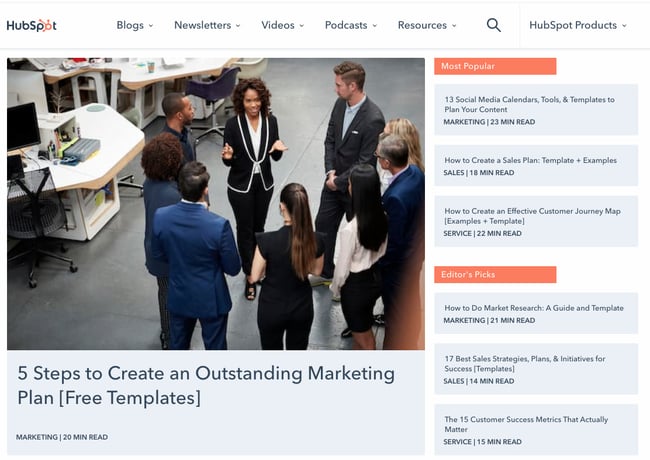 Don’t blog just because; blog with the intent to solve for the customer. To effectively do so, it’s important to understand your target audience and their pain points. That way, you can write highly targeted content that’s genuinely helpful for readers.
Don’t blog just because; blog with the intent to solve for the customer. To effectively do so, it’s important to understand your target audience and their pain points. That way, you can write highly targeted content that’s genuinely helpful for readers.
Online Marketing Benefits of Content Marketing
- Boosts Web Traffic: Regularly publishing fresh and relevant blog content can improve your SEO rankings, attracting more organic visitors to your website. Plus, sharing content on your social media pages and other channels can help you stay engaged with your audience while increasing visibility.
- Establishes Authority and Credibility: Sharing your expertise and insights through blog articles and other content can help establish you and your company as a thought leader in your industry. This also allows you to engage with your audience and provide them with useful information that speaks to their pain points. Not only does this build trust, but it also positions you as a reliable and knowledgeable resource.
- Generates Leads and Conversions: By creating engaging and relevant content, you can attract potential customers who are interested in your business and move them through the buyer’s journey. You can also convert readers into leads by including CTAs that encourage readers to take action, such as subscribing to a newsletter or registering for a free trial.
Recommended Reading
2. Paid Advertising
An organic content marketing strategy is only a portion of the story. It’s just as important to implement non-organic plays, such as paid advertising. Not only will this help you drive more brand awareness, it will also help you reach audiences who can’t find your business organically yet.
This is an important strategy to implement when you’re still growing your blog and not yet getting as much traffic as you want. There are a few types of advertising you should consider adding to your digital strategy:
Nearly every platform has an option for you to advertise — either through a display network (such as Google’s) or through its built-in ad system (such as Instagram’s, Facebook’s, and LinkedIn’s self-serve advertising portal).
Here’s one example of an ad on LinkedIn:
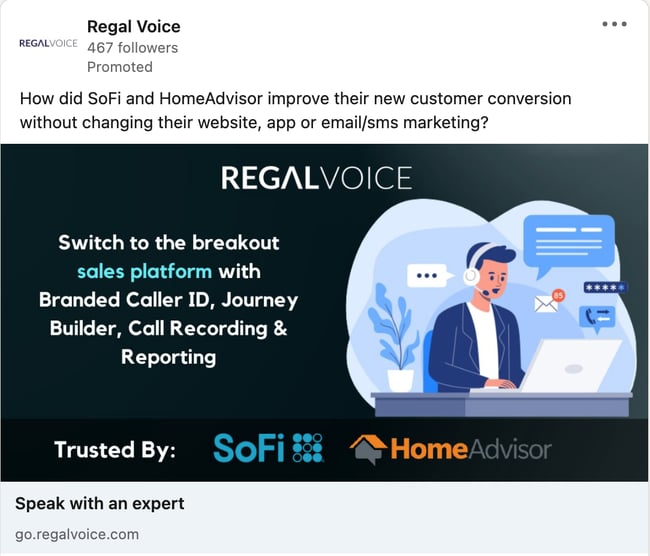
The benefit of advertising is that it’s not dependent on a content or SEO strategy. You simply need to write a few lines of copy, decide on imagery, and launch your advertising campaigns. To ensure that your campaigns are a success, you’ll want to create an advertising plan that outlines who you’re targeting, which channels you’ll be using, and how much you plan to spend.
We recommend downloading the following template to create your plan.
Featured Resource: Advertising Plan Template
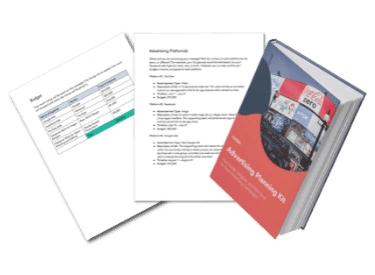 Download this Advertising Planning Kit
Download this Advertising Planning Kit
Online Marketing Benefits of Paid Advertising
- Targeted Campaigns: Platforms like Google, Facebook, and Instagram enable you to target your ads to specific audiences based on their demographics, interests, behaviors, and more. This helps ensure that your ads are seen by the right people who are more likely to be interested in your products or services.
- Measurable Results: No matter which platform you advertise on, you’ll be able to track the success of your ad campaigns by analyzing performance metrics such as impressions, clicks, and conversions. By analyzing this data, you can identify which ads and targeting strategies are most effective and make informed decisions to improve future campaigns.
- Flexibility: Paid advertising gives you the option to adjust your campaigns, targeting options, and budget based on your marketing goals and audience preferences. This can help you stay agile and responsive in the fast-moving digital marketing landscape and ensure that you are getting the most from your advertising budget.
3. Account-Based Marketing (ABM)
Account-based marketing is a strategic approach in marketing that focuses on targeting and engaging specific high-value accounts or key decision makers within those accounts. Rather than casting a wide net to reach a broad audience, ABM personalizes marketing efforts to cater to the needs and preferences of specific target accounts.
This strategy is particularly suitable for B2B organizations and industries with complex sales cycles, where forging strong relationships with specific key accounts is critical.
For instance, let’s say your software company wants to target a specific enterprise account, XYZ Inc. Instead of using a broad marketing approach, your company decides to adopt an ABM strategy to tailor their efforts specifically to XYZ Inc.
To do this, you would need to use tactics such as researching and understanding XYZ Inc.’s pain points and business objectives, developing personalized content tailored to their needs, engaging with decision makers and nurturing relationships with them, and coordinating your marketing and sales efforts.
Featured Resource: How to Implement an ABM Strategy
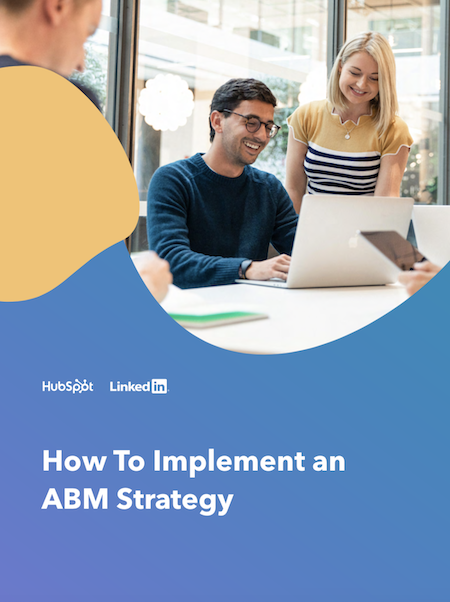
Online Marketing Benefits of Account-Based Marketing
- Personalized Approach: Unlike other marketing strategies, ABM enables you to create tailor-made content, communications, and campaigns for each account you target. This level of personalization helps you establish stronger relationships with your target accounts and increase the likelihood of conversion.
- Alignment Between Marketing and Sales: Alignment between your marketing and sales team is crucial for implementing a successful ABM strategy. It ensures that both teams are focused on the same goals and committed to creating consistent experiences for accounts.
- Improved Customer Retention: ABM emphasizes building long-term relationships with target accounts. By understanding their specific needs and providing relevant solutions, marketers can increase customer satisfaction, retention, and even drive further expansion within the account.
Recommended Reading
4. Search Engine Optimization (SEO)
SEO is the practice of optimizing your web content, structure, and technical aspects to improve its visibility and ranking on search engine results pages (SERPs). The ultimate goal of SEO is to increase organic, non-paid traffic to your website from search engines like Google and Bing.
If your product pages aren’t earning traffic, SEO is your best bet to get those pages in front of those who are searching for those products and services. To ensure that your content engages and converts users, it’s important to invest in an on-page SEO strategy.
Not sure how to get started? Download our starter pack below.
Featured Resource: SEO Starter Pack 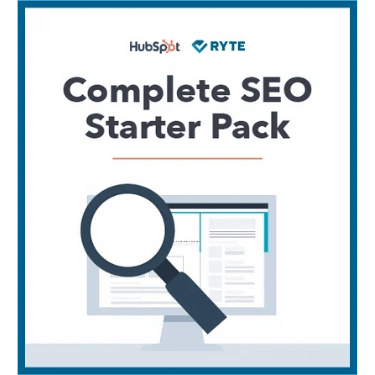
Online Marketing Benefits of SEO
- Increases Organic Traffic: Optimizing your digital content for search engines can help you rank higher in search engine results pages (SERPs) for relevant keywords that your audience is using. As your ranking increases, so does your brand’s visibility and your website’s organic traffic.
- Improves User Experience: When it comes to getting higher rankings, optimizing your website for users is just as important as optimizing for search engines. This includes ensuring that your website is easy to navigate and has a clear hierarchy of information so users can quickly find what they are looking for. In doing this, you not only improve the user experience, but you also increase the chances of users staying on your website longer, engaging with your brand, and ultimately, becoming customers.
- Provides Long-Term Benefits: Unlike paid advertising, which requires ongoing investment, optimizing your content for search engines can provide long-term benefits by driving consistent and ongoing organic traffic to your website. Yes, it can take longer to reach your goals, but the payoff includes saving your business money and building an authentic brand reputation.
Recommended Reading
5. Social Media Marketing

Social media marketing is another way to generate brand awareness online and boost your digital strategy. It involves creating and sharing content on social media platforms, such as Facebook, Instagram, Twitter, and others, to attract attention, drive website traffic, and generate leads.
Social media marketing is especially useful for building a community around your brand because it enables you to speak directly to your audience. Engaging with your followers through comments, messages, and discussions allows you to connect with them on a more personal level. The stronger relationship you have with your audience, the more loyal they will be to your brand.
Online Marketing Benefits of Social Media Marketing
- Increases Brand Awareness: With billions of active social media users, you can reach a wide audience and increase your brand’s visibility. This is especially true if you participate in relevant social media trends, run paid campaigns, create and promote branded hashtags, and collaborate with other brands.
- Boosts Engagement: A strong social media presence can help create a community around your brand and build a strong relationship with your followers. Plus, you can use tactics like contests and giveaways to encourage specific actions that support your marketing goals, such as asking users to tag a friend or write a review.
- Rich Insights and Analytics: Social media platforms typically provide robust analytics tools that allow you to measure the effectiveness of your marketing campaigns, track key metrics, and gain insights for continuous improvement.
Recommended Reading
6. Influencer Marketing
The global market for influencer marketing has more than doubled since 2019, making it more popular than ever. By partnering with influencers, brands can create content that promotes their products or services while leveraging the influencer’s reach.
There are many ways you can partner with influencers, such as sponsored content, guest blogging, product collaborations, influencer takeovers, and more.
Before partnering with an influencer, it’s important to do your research and make sure they have an engaged following within your industry or niche and are aligned with your values and messaging. Not sure how to get started? Check out HubSpot’s Ultimate Guide to Influencer Marketing.
Featured Resource: The Ultimate Guide to Influencer Marketing
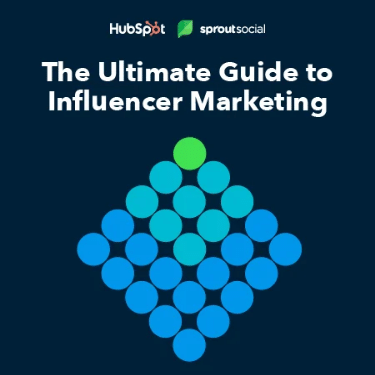
Online Marketing Benefits of Influencer Marketing
- Brand Exposure: Partnering with influencers allows you to tap into the influencer’s existing audience and reach, which can significantly boost your brand’s awareness. By leveraging an influencer’s platform and following, you can expose your products or services to a larger audience and gain visibility among potential new customers.
- Authentic Content Creation: Influencers are skilled in creating engaging and authentic content that resonates with their followers. By partnering with influencers, you can tap into their creativity and expertise to develop compelling content that promotes your brand’s offerings in an organic and relatable manner. Plus, user-generated content created by influencers can showcase real-life experiences with your brand, which can influence buyer decisions and foster trust.
- Trust and Credibility: Influencers are seen as trusted authorities within their niches. When they endorse or recommend a brand’s products or services, it adds credibility and trust. This can positively influence consumer perceptions and increase the likelihood of potential customers trying or purchasing from your brand.
Recommended Reading
7. Podcasting
Audio marketing has been on the rise — all you have to do is look at the ways Clubhouse and Twitter Spaces have gone head-to-head to earn market share. While platforms such as Clubhouse are different from podcasting, the idea is the same: You get to educate and engage an audience while they’re on the go. All they need is a device that plays audio.
For inspiration, check out the HubSpot Podcast Network:
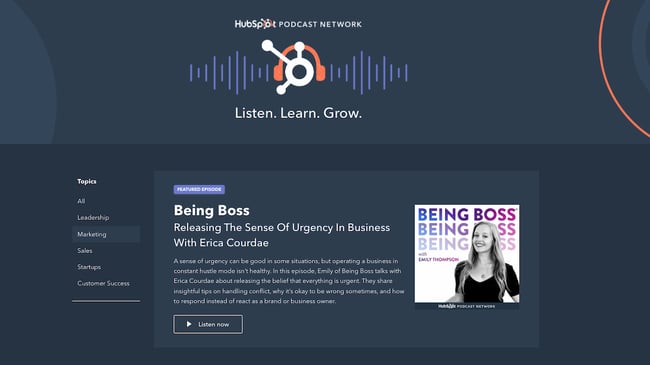
Podcasts can become an essential element in your digital strategy, allowing you to reach people on platforms other than search engines and social media channels. Plus, it’s a much more unplanned, natural medium — though of course you should plan each episode carefully and ensure you’re delivering content that actually serves your readership.
Featured Resource: How to Start a Podcast 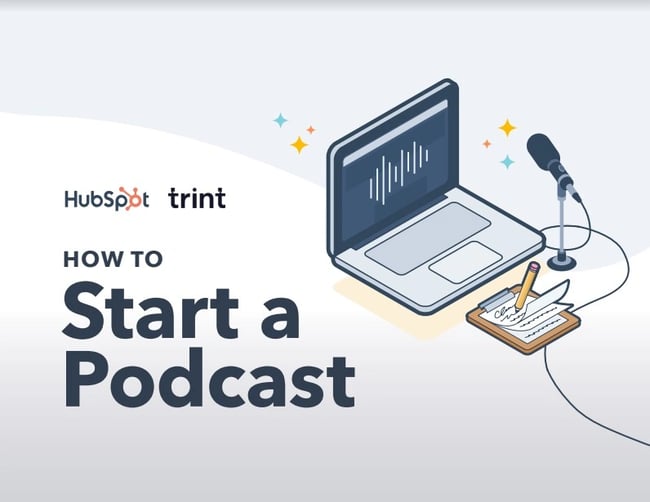
Online Marketing Benefits of Podcasting
- Discoverability: Podcasts can be hosted on various platforms, such as Spotify, Apple Podcasts, and Stitcher, expanding your brand’s reach. You can also transcribe your podcasts and publish the transcript to make them more SEO-friendly. Plus, you can invite guests to speak on your podcast and have them share the episode with their followers.
- Authenticity: Podcasting allows for a more conversational tone compared to other forms of content. The audio format lends itself to authentic and unscripted conversations, creating a sense of connection and genuine interaction between you and your listeners.
- Sustainable: Podcasts have a long shelf life and can remain relevant for months to come, helping you get the most out of your content. Plus, you can repurpose the audio material to create blog posts, videos, ebooks, and other types of content.
Recommended Reading
8. Email Marketing
Email marketing is one of the most important digital strategies you can implement today. It gives you plenty of opportunities to nurture customers who are highly interested in your products. After all, you wouldn’t be subscribed to a newsletter of a brand that doesn’t interest you, and a business isn’t supposed to email customers who haven’t signed up to its mailing list, anyway. Not unless it wants to risk diminishing email deliverability.
You can earn subscribers through your blog, through contests, and even through webinars. Any time someone gives you their email — and every time they give consent to receive communication from you — you have full permission to target them with an email marketing campaign.
Featured Resource: Email Marketing Planning Template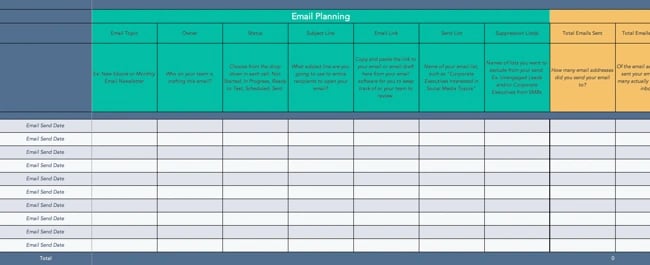
Online Marketing Benefits of Email Marketing
- Builds Relationships: Email allows you to communicate directly with your audience, establishing a personal relationship and building trust over time. You can also customize email campaigns to the interests and unique preferences of your target audience, providing more content that is relevant to their needs.
- Drives Traffic to Your Website: Emails with links to your website or blog can drive traffic to your website and engage with your brand. You can even send your email subscribers exclusive deals, promotions, or discounts, which can increase the potential for conversions.
- Easy to Track: Email marketing campaigns can be tracked and measured, providing valuable insights such as open rates, click-through rates, conversion rates, bounce rates, and unsubscribe rates. By analyzing these metrics, you can make data-driven decisions that can help you reach your target audience more effectively.
Recommended Reading
9. Video Marketing
With platforms like TikTok and Instagram Reels on the rise, video marketing is more popular — and effective — than ever. In fact, 92% of video marketers surveyed by Wyzowl reported they get a positive ROI on video content.
One of the reasons why videos are so effective is because they allow you to communicate with your audience in a more personal way. Plus, you can include a lot of information in a short video, keeping your audience engaged and saving them time.
By making video an integral part of your digital strategy, you’re able to showcase your brand’s creativity and explore more content formats, such as product demos, explainer videos, expert interviews, customer testimonials, and more.
Online Marketing Benefits of Video Marketing
- Boosts SEO: Since Google tends to prioritize video content in its search results, implementing video as part of your marketing strategy can improve your search engine visibility. Plus, video content can be optimized with relevant titles, descriptions, and keywords, making it easier for search engines to understand and categorize the content.
- Better Retention: Video is easier to remember than text-based content because it allows you to use storytelling techniques and communicate important messages more effectively. Video has the power to invoke emotions and create a connection with your audience, making it easier for them to consume and remember your content.
- Enhances Reach: Video is highly shareable on social media due to their easily digestible nature. As people share your video content with their own social media networks, it exposes your brand to new audiences.
Recommended Reading
Now it‘s time to bring all of this together to form a cohesive marketing strategy document. Your strategy document should map out the series of actions you’re going to take to achieve your goals, based on your research up to this point.
Let’s discuss how our digital strategy template can help.
Digital Marketing Strategy Template
While a spreadsheet can be an efficient format for mapping your digital marketing strategy, that approach can quickly become messy and overwhelming.
To plan your strategy for the long-term – typically between six to 12 months out, you need a reliable digital marketing strategy document. But, where to start? With our free digital marketing plan template.
This template will walk you through your business summary and initiatives, help you build your target market and competitor information, and flesh out your marketing strategy — including your budget and specific channels and metrics.
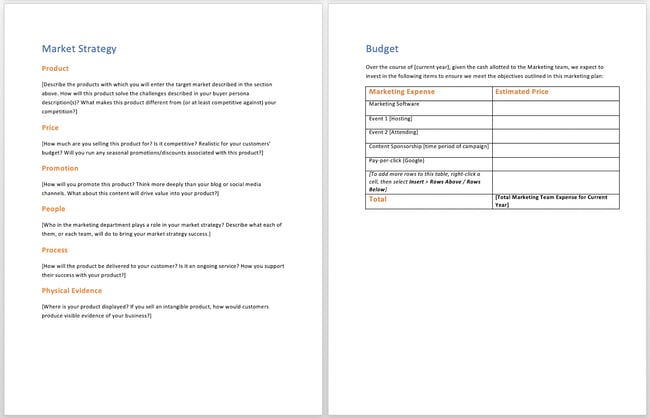
Use this digital strategy template to build out your annual digital marketing strategy and tactics. By planning out these yearly plans, you can overlay when you and your team will be executing each action. For example:
- In January, you’ll start a blog that will be continually updated once a week, for the entire year.
- In March, you’ll launch a new ebook, accompanied by paid promotion.
- In July, you’ll prepare for your biggest business month — what do you hope to have observed at this point that will influence the content you produce to support it?
- In September, you’ll focus on earned media in the form of PR to drive additional traffic during the run-up.
This approach provides a structured timeline for your activity which will help communicate plans among colleagues.
Finally, here are some examples of digital marketing campaigns and their strategies to inspire you.
Digital Marketing Campaign Examples
1. Béis: Paid Ad
Travel accessory brand, Béis, recently launched a social media campaign to announce feature updates to one of its products. And they did it in the best way: by showing instead of telling.

In a 34-second clip distributed on Instagram Stories, the brand showed how their product performed before and how it performs now following some changes to the material.
This is a fantastic campaign as it not only highlights an improvement on a product but it also shows customers that the brand is constantly iterating and improving. Secondly, they make sure to include captions in the video to ensure that it’s accessible without sound. Thirdly, there’s a CTA button at the bottom of the screen that encourages customers to make a purchase.
2. Omsom: Social Media
Asian food brand Omsom creates starter kits for home cooks who want a simple way to cook Asian cuisine without sacrificing authentic ingredients and flavors. The brand leverages its TikTok profile to share behind-the-scenes content, recipes, and culturally relevant content.
In a recent video, the brand’s co-founder shared how it sources one of its key ingredients and how they chose the more difficult route to preserve the integrity of the food.
Here‘s what Omsom did right: They highlighted their brand’s values while still building excitement around the product. The also include their website link in their TikTok bio and even offer a discount to customers who found them through the video-sharing platform.
Sharing behind-the-scenes content is a great way to connect with your audience and share details that will simultaneously highlight your mission and/or values.
3. The General: Paid Advertising
After reports that consumers thought the brand was untrustworthy due to its low-budget ads, The General decided to revamp its entire marketing strategy.
In a commercial featuring basketball superstar, Shaq, the brand addressed the elephant in the room and introduced a new-and-improved look.
In addition, they also emphasize their credibility by mentioning how long they‘ve been in business and how many people they’ve helped.
By addressing negative perceptions head-on, brands can not only change how consumers view them but also show that they are in tune with their target audience.
Grow Better With Marketing Strategies That Improve Your Digital Presence
Your strategy document will be very individual to your business, which is why it’s almost impossible for us to create a one-size-fits-all digital marketing strategy template.
Remember, the purpose of your strategy document is to map out the actions you‘re going to take to achieve your goal over a period of time — as long as it communicates that, then you’ve nailed the basics of creating a digital strategy.
If you’re eager to build a truly effective strategy to help grow your business, check out our free collection of content marketing templates below.
Editor’s note: This post was originally published in October 2019 and has been updated for comprehensiveness.
This article was written by a human, but our team uses AI in our editorial process. Check out our full disclosure to learn more about how we use AI.
[ad_2]
Source link


![Download Now: Free Marketing Plan Template [Get Your Copy]](https://no-cache.hubspot.com/cta/default/53/aacfe6c7-71e6-4f49-979f-76099062afa0.png)

